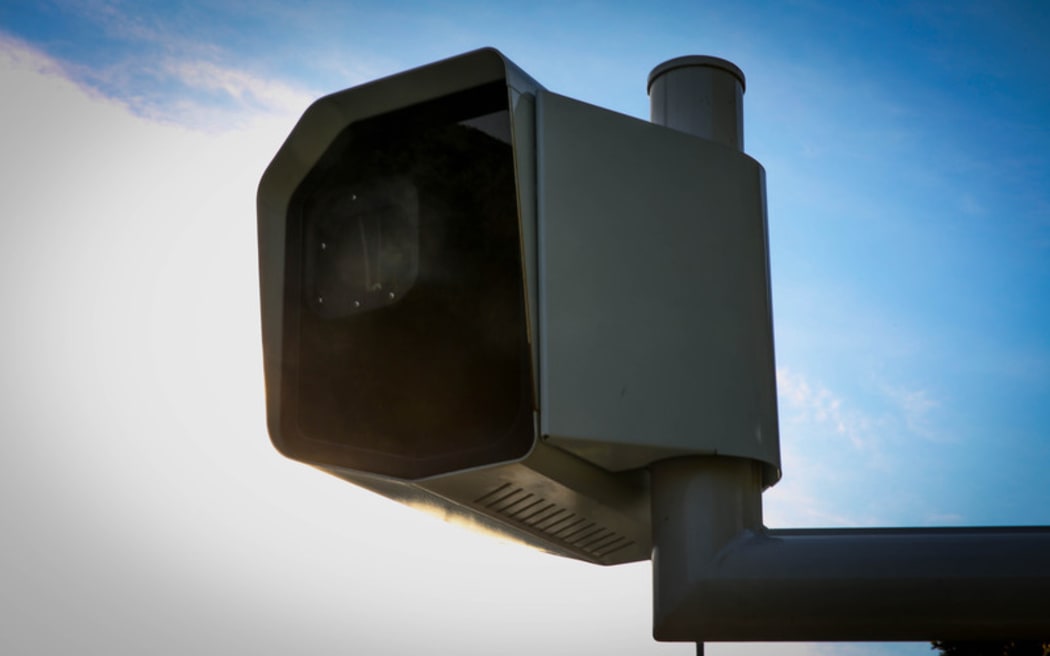
Wellington's Ngauranga Gorge. Photo: RNZ / Alexander Robertson
Waka Kotahi says new road safety cameras that track a car's speed over a length of road are way more effective at reducing crashes than fixed spot speed cameras.
The so-called point-to-point cameras average a vehicle's speed over the journey between two cameras. They are being installed along stretches of six roads that are considered high-risk crash areas in the Auckland region.
The cameras will be tested for a while and data gathered before they are used for enforcement and tickets start being issued.
Waka Kotahi head of regulatory strategic programs Tara Macmillan told Checkpoint on Wednesday she expects a 50 percent reduction in the number of people who are seriously injured or killed on the roads they are installed on.
"What you see out on New Zealand roads at the moment is the majority of our cameras are fixed speed cameras - so when you pass that camera, it clocks your speed, and if you're travelling over the posted speed limit, then you're at risk of getting an infringement.
"We're bringing in these new generation cameras that are already getting used internationally, and what these cameras do is they calculate average speed across the length of road between two cameras."
The twin camera systems will be installed on roads in Warkworth, Dairy Flat, Redvale, Shamrock Park, Karaka and Glenbrook.
This system has proven itself internationally, she said, with research showing they slow drivers down for the entire length of road between the two cameras, rather than just the point where a traditional single speed camera sits.
"Drivers are only ticketed if the average speed over the entire distance between the two cameras is over the limit - so you can't be pinged by a single camera," Macmillan explained.
"Typically over the length of an average speed corridor, drivers will ensure that they're travelling at that speed limit - so we get a reduction in speed typically over that over that full full length. We typically put in at high risk locations on our roads - so where we've got kind of windy roads, there are high crashes occurring in multiple locations on a stretch of road and we're typically seeing people travelling over the posted and speed limit.
"So they're really effective of reducing crashes over a length of road, and the more crashes that we reduce, the more deaths and serious injuries we avoid."
They are expected to be operating by December, but for the first four weeks will not issue infringements. Motorists will get a chance to understand where they are and plenty of notice before they start ticketing speeding drivers, Macmillan said.
"This isn't about catching drivers out. This is about lowering speeds and reducing crashes at these high high risk locations. The cameras will be clearly signposted, and that's to enable people to get a reminder to check their speed and slow down if necessary."
Police officer shocked at parents' lack of care
A veteran police officer is lost for words after seatbelt checkpoints in Taupō found, over seven weeks, 94 drivers ferrying children who were not wearing seatbelts or in appropriate booster seats.
"It was very disappointing, and what was even worse is that a lot of the adults wore seatbelts, but they never cared to make sure their children were seatbelted in," Sergeant Wayne Dickson told Checkpoint.
"The worst was up to five children unrestrained, and it was common we'd pick up two or three children sitting in one seatbelt. I'm talking about children under five years old, and clearly they're going to get hurt if the vehicles have to stop suddenly."
Many of the drivers had a "casual" attitude towards putting their tamariki at risk of catapulting through the windscreen, he said.
"They were just picking the children up and just going around the corner, they weren't going far. Some of them were that they were picking the children up for other family members, but a lot of them said that they have the carseats in other cars or at home.
"And what we found was that there was less than five out of all our people stopped, less than five actually didn't own or have access to car seats. Most of them had the carseats, but they just didn't think it was important enough to use them properly."
Sometimes multiple small children were sharing a single adult seatbelt, he said, with the belt "right across their face[s]".
He said it was difficult to understand why so many drivers did not bother to use boosters and child car seats, when cost was not an issue for any of them.
"Every parent we stopped, of course they love their children, they don't want their children to get hurt. But I think what it comes down to is they just think that because they're going for a short trip, they think they'll be okay, and because they think they're a good driver, nothing will happen to them. They always think crashes happen to other people…
""Just don't take the chance, because the day you think that you can take a chance and you're okay, that's possibly the day you're gonna get caught out and you'll live to regret that if anything happened to the young people."
Dickson said he was unsure what more police could do to get the message through.

